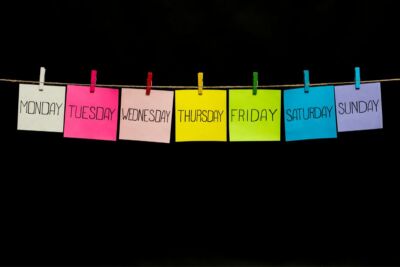Immagina di essere a un colloquio di lavoro in cui ti viene chiesto dove ti vedi tra cinque anni, o magari stai pianificando un viaggio con amici e devi discutere dei tuoi programmi per il prossimo fine settimana. In entrambi i casi, è fondamentale saper parlare del futuro in inglese. La capacità di esprimere chiaramente le tue intenzioni, previsioni e piani futuri può fare la differenza non solo nella vita quotidiana ma anche in contesti professionali.
Indice
ToggleImportanza di saper parlare del futuro in inglese
Parlare del futuro è essenziale per comunicare efficacemente in inglese. Che tu stia discutendo delle tue aspirazioni personali, pianificando attività o anticipando eventi, sapere come usare correttamente le forme del futuro ti permetterà di esprimerti in modo chiaro e preciso. Inoltre, molte situazioni professionali richiedono la capacità di discutere progetti e previsioni future, dal presentare una strategia aziendale a partecipare a meeting internazionali.
Situazioni quotidiane e professionali in cui si utilizza il futuro
Vita quotidiana:
- Pianificazione di vacanze o eventi.
- Discussioni sui progetti del weekend.
- Predizioni sul tempo o sugli avvenimenti futuri.
Ambito professionale:
- Colloqui di lavoro e discussioni sulle prospettive di carriera.
- Presentazioni di progetti e piani aziendali.
- Previsioni di mercato e strategie di business.
L’obiettivo di questo articolo è fornire una panoramica completa delle diverse forme utilizzate per esprimere il futuro in inglese. Esamineremo vari modi di parlare del futuro, come il Simple Future, il “Going to”, il Present Continuous per il futuro, e altre forme meno comuni ma altrettanto importanti. Inoltre, verranno forniti esempi pratici e consigli utili per aiutarti a padroneggiare l’uso del futuro in inglese, sia nella vita quotidiana che in contesti professionali.
Futuro Semplice (Simple Future)
Formazione del Simple Future
Il Simple Future in inglese si forma utilizzando l’ausiliare “will” seguito dal verbo base. Questa forma è molto semplice e diretta, rendendola una delle prime che gli studenti imparano.
Struttura:
- Affermativa: Soggetto + “will” + verbo base.
- Esempio: I will go to the store.
- Negativa: Soggetto + “will not” (won’t) + verbo base.
- Esempio: She will not (won’t) attend the meeting.
- Interrogativa: “Will” + soggetto + verbo base?
- Esempio: Will they join us for dinner?
Uso del Simple Future
Il Simple Future viene utilizzato in diverse situazioni specifiche:
- Decisioni istantanee:
- Utilizzato per esprimere decisioni prese al momento.
- Esempio: I forgot my keys. I will go back and get them.
- Previsioni non basate su evidenze:
- Utilizzato per fare previsioni generali o personali sul futuro.
- Esempio: I think it will rain tomorrow.
- Offerte e promesse:
- Utilizzato per fare promesse o offerte spontanee.
- Esempio: I will help you with your homework.
Esempi pratici del Simple Future
Frasi comuni e situazioni tipiche:
- Decisioni istantanee:
- “I will call you back in a minute.”
- “We will take a taxi.”
- Previsioni non basate su evidenze:
- “He will probably come to the party.”
- “People will travel to Mars in the future.”
- Offerte e promesse:
- “I will send you the report by the end of the day.”
- “She will bring the dessert to the dinner.”
Questi esempi mostrano come il Simple Future possa essere applicato in varie situazioni quotidiane e professionali, permettendo di comunicare con chiarezza ed efficacia riguardo al futuro.
Futuro con “Going to”
Formazione del “Going to”
Il futuro con “going to” si forma utilizzando la struttura “to be” (conjugato secondo il soggetto) + “going to” + verbo base. Questa forma è comunemente usata per esprimere intenzioni o piani futuri e previsioni basate su evidenze attuali.
Struttura:
- Affermativa: Soggetto + “to be” + “going to” + verbo base.
- Esempio: She is going to study tonight.
- Negativa: Soggetto + “to be” + “not” + “going to” + verbo base.
- Esempio: They are not (aren’t) going to attend the conference.
- Interrogativa: “To be” + soggetto + “going to” + verbo base?
- Esempio: Are you going to visit your parents this weekend?
Uso del “Going to”
Il “going to” viene utilizzato principalmente in due contesti:
- Intenzioni e piani:
- Utilizzato per parlare di azioni pianificate o intenzioni future.
- Esempio: I am going to start a new project next month.
- Previsioni basate su evidenze presenti:
- Utilizzato per fare previsioni basate su evidenze visibili o su qualcosa di noto.
- Esempio: Look at those clouds. It is going to rain.
Esempi pratici del Going to
Frasi comuni e situazioni tipiche:
- Intenzioni e piani:
- “We are going to move to a new house next year.”
- “He is going to take a break after finishing this project.”
- Previsioni basate su evidenze presenti:
- “She is going to have a baby.”
- “Watch out! You are going to spill your coffee.”
Questi esempi illustrano come il “going to” possa essere utilizzato per comunicare chiaramente sia piani futuri che previsioni basate su evidenze presenti. È una forma versatile e molto utilizzata nella lingua inglese quotidiana e professionale.
Present Continuous per il Futuro
Formazione del Present Continuous
Il Present Continuous si forma utilizzando la struttura “to be” (conjugato secondo il soggetto) + verbo-ing. Sebbene sia principalmente utilizzato per esprimere azioni in corso nel presente, può anche essere usato per parlare di eventi futuri già programmati.
Struttura:
- Affermativa: Soggetto + “to be” + verbo-ing.
- Esempio: I am meeting my friends tomorrow.
- Negativa: Soggetto + “to be” + “not” + verbo-ing.
- Esempio: She is not (isn’t) coming to the party.
- Interrogativa: “To be” + soggetto + verbo-ing?
- Esempio: Are they leaving for the trip next week?
Uso del Present Continuous per il Futuro
Il Present Continuous è utilizzato per parlare di eventi futuri che sono già stati pianificati o organizzati. Questa forma enfatizza che l’evento è già deciso e spesso implica una qualche forma di preparazione o accordo.
- Eventi futuri già programmati:
- Utilizzato per esprimere appuntamenti, incontri o eventi pianificati.
- Esempio: I am having dinner with my boss tonight.
- Differenze con il “Going to”:
- Il Present Continuous è spesso usato per eventi con una maggiore certezza e pianificazione rispetto al “going to”.
- Esempio: We are flying to New York next Monday (già prenotato) vs. We are going to fly to New York next Monday (intenzione).
Esempi pratici del Present Continuous per il Futuro
Frasi comuni e situazioni tipiche:
- Eventi futuri già programmati:
- “I am starting a new job next week.”
- “She is visiting her grandparents this weekend.”
- Differenze con il “Going to”:
- “They are getting married in June.” (già fissata la data)
- “We are having a meeting with the clients tomorrow morning.” (già programmato e confermato)
Utilizzare il Present Continuous per parlare del futuro è particolarmente utile per descrivere piani concreti e dettagliati. Questa forma di futuro trasmette un senso di certezza e organizzazione, rendendo la comunicazione più precisa e affidabile.
Futuro Perfetto (Future Perfect)
Formazione del Future Perfect
Il Future Perfect si forma utilizzando “will have” seguito dal participio passato del verbo. Questa struttura viene utilizzata per indicare che un’azione sarà completata entro un certo momento nel futuro.
Struttura:
- Affermativa: Soggetto + “will have” + participio passato.
- Esempio: By next year, I will have graduated from university.
- Negativa: Soggetto + “will not have” (won’t have) + participio passato.
- Esempio: They will not (won’t) have finished the project by tomorrow.
- Interrogativa: “Will” + soggetto + “have” + participio passato?
- Esempio: Will you have completed the report by the deadline?
Uso del Future Perfect
Il Future Perfect viene utilizzato per parlare di azioni che saranno completate entro un determinato momento nel futuro. È particolarmente utile per esprimere deadline e scadenze.
- Azioni completate entro un determinato momento:
- Utilizzato per descrivere qualcosa che sarà finito prima di un altro evento futuro.
- Esempio: By the time she arrives, we will have cleaned the house.
- Deadline e scadenze:
- Utilizzato per indicare che qualcosa sarà completato entro una certa data o ora.
- Esempio: The team will have submitted the proposal by the end of the week.
Esempi pratici del Future Perfect
Frasi comuni e situazioni tipiche:
- Azioni completate entro un determinato momento:
- “By the end of the course, I will have learned how to speak French.”
- “She will have saved enough money to buy a car by next summer.”
- Deadline e scadenze:
- “We will have finished the project by the time the boss returns.”
- “He will have written his first book by the time he turns thirty.”
Il Future Perfect è una forma utile per esprimere chiaramente che un’azione sarà conclusa entro un certo momento nel futuro. È particolarmente rilevante in contesti professionali e accademici, dove spesso è necessario rispettare delle scadenze. Utilizzare correttamente il Future Perfect aiuta a comunicare in modo preciso e affidabile, mostrando una chiara comprensione delle tempistiche future.
Futuro Perfetto Continuo (Future Perfect Continuous)
Formazione del Future Perfect Continuous
Il Future Perfect Continuous si forma utilizzando “will have been” seguito dal verbo in forma -ing. Questa struttura è utilizzata per indicare che un’azione sarà in corso fino a un certo momento nel futuro.
Struttura:
- Affermativa: Soggetto + “will have been” + verbo-ing.
- Esempio: By next month, I will have been working here for a year.
- Negativa: Soggetto + “will not have been” (won’t have been) + verbo-ing.
- Esempio: She will not (won’t) have been studying for long before the exam.
- Interrogativa: “Will” + soggetto + “have been” + verbo-ing?
- Esempio: Will they have been living here for six months by then?
Uso del Future Perfect Continuous
Il Future Perfect Continuous viene utilizzato per parlare di azioni che saranno in corso fino a un determinato momento nel futuro. È particolarmente utile per enfatizzare la durata di un’azione fino a quel punto specifico.
- Azioni in corso fino a un determinato momento:
- Utilizzato per descrivere un’azione che è iniziata nel passato, continua nel presente e proseguirà fino a un punto specifico nel futuro.
- Esempio: By 2025, he will have been teaching at the university for 20 years.
- Enfasi sulla durata:
- Utilizzato per enfatizzare quanto tempo un’azione sarà durata entro un certo momento.
- Esempio: By the time she gets here, we will have been waiting for over an hour.
Esempi pratici del Future Perfect Continuous
Frasi comuni e situazioni tipiche:
- Azioni in corso fino a un determinato momento:
- “By the end of this week, I will have been working on this project for six months.”
- “They will have been traveling for three weeks by the time they reach their destination.”
- Enfasi sulla durata:
- “By next year, she will have been studying medicine for a decade.”
- “He will have been playing the piano for fifteen years by the time he performs at the concert.”
Il Future Perfect Continuous è una forma utile per esprimere la durata di un’azione fino a un certo momento nel futuro. È particolarmente rilevante in contesti accademici e professionali, dove spesso è importante sottolineare l’esperienza accumulata nel tempo. Utilizzare correttamente il Future Perfect Continuous permette di comunicare in modo preciso ed efficace, evidenziando la continuità e la durata delle azioni future.
Altre Forme di Futuro
Modali per il Futuro
Oltre alle forme di futuro più comuni, l’inglese utilizza anche verbi modali per esprimere il futuro. Questi verbi modali aggiungono sfumature di significato e possono indicare probabilità, possibilità, obblighi o suggerimenti.
- Uso di “shall” e “should” per esprimere futuro:
- “Shall”: Tradizionalmente utilizzato nelle prime persone (I, we) per fare offerte o suggerimenti. Oggi è meno comune e spesso sostituito da “will”.
- Esempio: Shall we go to the park?
- “Should”: Utilizzato per dare consigli o suggerire azioni future.
- Esempio: You should see a doctor if you feel sick.
- “Shall”: Tradizionalmente utilizzato nelle prime persone (I, we) per fare offerte o suggerimenti. Oggi è meno comune e spesso sostituito da “will”.
- Altri modali (can, may, might) e il loro uso nel futuro:
- “Can”: Usato per esprimere possibilità o capacità future.
- Esempio: I can help you with your homework tomorrow.
- “May” e “Might”: Utilizzati per esprimere possibilità future.
- Esempio: It may rain later this afternoon.
- Esempio: She might join us for dinner.
- “Can”: Usato per esprimere possibilità o capacità future.
Future in the Past
Il “Future in the Past” viene utilizzato per parlare di un’azione futura che era prevista o pianificata nel passato. Ci sono due forme principali per esprimere il Future in the Past: “was/were going to” e “would”.
- “Was/Were going to”:
- Utilizzato per descrivere un’intenzione o un piano futuro visto dal punto di vista del passato.
- Esempio: I was going to call you, but I forgot.
- “Would”:
- Utilizzato come forma del passato di “will”, spesso in contesti di narrazione.
- Esempio: She promised she would help me with the project.
Esempi pratici
Frasi comuni e situazioni tipiche:
- Uso di “shall” e “should”:
- “Shall we start the meeting now?” (offerta/suggerimento)
- “You should prepare for the exam in advance.” (consiglio)
- Altri modali:
- “I can meet you at the office tomorrow.” (capacità futura)
- “They might go on a vacation next month.” (possibilità futura)
- Future in the Past:
- “He was going to join us, but he got sick.” (intenzione nel passato)
- “She said she would send the email by the end of the day.” (promessa nel passato)
Queste forme alternative per esprimere il futuro in inglese offrono una gamma di opzioni per comunicare intenzioni, possibilità e piani in modo più sfumato e preciso. Conoscere e saper utilizzare questi verbi modali e il Future in the Past può arricchire la tua capacità di esprimerti in inglese, rendendo la tua comunicazione più varia e dettagliata.
Confronti e Uso Appropriato
Confronto tra le varie forme
Capire quando utilizzare una forma del futuro rispetto a un’altra può essere complesso. Ogni forma ha sfumature specifiche e contesti appropriati. Ecco un confronto tra le principali forme del futuro per aiutarti a scegliere quella giusta.
- “Will” vs “Going to”:
- “Will”:
- Decisioni prese al momento: I will answer the phone.
- Previsioni non basate su evidenze: It will probably rain tomorrow.
- Offerte e promesse: I will help you with your homework.
- “Going to”:
- Intenzioni e piani già formati: I am going to start a new job next month.
- Previsioni basate su evidenze presenti: Look at those clouds. It is going to rain.
- “Will”:
- “Will” vs Present Continuous:
- “Will”:
- Decisioni istantanee e offerte: I will call you back.
- Present Continuous:
- Eventi futuri già programmati: I am meeting John at 3 PM.
- “Will”:
- Present Continuous vs “Going to”:
- Present Continuous:
- Eventi futuri già fissati con orari e piani certi: We are having a meeting at 10 AM tomorrow.
- “Going to”:
- Intenzioni future senza una programmazione rigida: I am going to visit my grandmother next weekend.
- Present Continuous:
- Future Perfect vs Future Perfect Continuous:
- Future Perfect:
- Azioni completate entro un determinato momento nel futuro: By next year, I will have graduated.
- Future Perfect Continuous:
- Durata di un’azione fino a un momento specifico nel futuro: By next year, I will have been studying for three years.
- Future Perfect:
Errori comuni e come evitarli
- Confusione tra “will” e “going to”:
- Errore: I think it is going to rain tomorrow. (senza evidenze)
- Correzione: I think it will rain tomorrow.
- Utilizzo errato del Present Continuous per eventi non programmati:
- Errore: I am going to a party this weekend. (senza dettagli specifici)
- Correzione: I am going to a party this weekend. (quando il programma è già fissato)
- Non utilizzare il Future Perfect quando necessario:
- Errore: I will finish the project by next week.
- Correzione: I will have finished the project by next week.
Consigli pratici per l’apprendimento
- Esercizi e attività consigliate:
- Scrittura: Scrivi diari o piani settimanali utilizzando diverse forme del futuro.
- Conversazione: Pratica con amici o tutor, pianificando eventi futuri e facendo previsioni.
- Lettura: Leggi articoli e libri in inglese, prestando attenzione alle diverse forme del futuro utilizzate.
- Risorse utili (libri, app, siti web):
- Libri di grammatica: “English Grammar in Use” di Raymond Murphy.
- App: Duolingo, Babbel per esercizi interattivi.
- Siti web: BBC Learning English, Grammarly Blog per articoli e spiegazioni.
Utilizzando questi confronti e consigli, potrai migliorare la tua padronanza delle forme del futuro in inglese, evitando errori comuni e comunicando in modo più preciso ed efficace.
Tabella Riassuntiva Delle Forme Del Futuro In Inglese
| Forma del Futuro | Struttura | Uso | Esempio |
| Simple Future (will) | Soggetto + will + verbo base | Decisioni istantanee, previsioni non basate su evidenze, offerte e promesse | I will call you tomorrow. |
| Going to | Soggetto + to be + going to + verbo base | Intenzioni e piani futuri, previsioni basate su evidenze presenti | I am going to visit my parents next week. |
| Present Continuous | Soggetto + to be + verbo-ing | Eventi futuri già programmati | I am meeting my friend tonight. |
| Future Perfect | Soggetto + will have + participio passato | Azioni completate entro un determinato momento nel futuro | By next year, I will have graduated. |
| Future Perfect Continuous | Soggetto + will have been + verbo-ing | Durata di un’azione fino a un momento specifico nel futuro | By next year, I will have been studying here for three years. |
Esercizi e Quiz
Esercizio 1: Simple Future (will)
Istruzioni: Completa le frasi usando la forma corretta del Simple Future (“will”).
- I think it ______ (rain) tomorrow.
- She ______ (help) you with your homework.
- We ______ (go) to the cinema tonight.
- He ______ (call) you back in a minute.
- They ______ (visit) their grandparents next weekend.
Esercizio 2: Going to
Istruzioni: Completa le frasi usando la forma corretta di “going to”.
- Look at the dark clouds. It ______ (rain).
- I ______ (buy) a new laptop soon.
- They ______ (move) to a new house next month.
- She ______ (start) a new job next week.
- We ______ (have) a party this Saturday.
Esercizio 3: Present Continuous per il Futuro
Istruzioni: Completa le frasi usando la forma corretta del Present Continuous.
- I ______ (meet) my friends for dinner tonight.
- He ______ (fly) to Paris next Monday.
- We ______ (attend) a conference next weekend.
- She ______ (start) her new course in September.
- They ______ (visit) us tomorrow afternoon.
Esercizio 4: Future Perfect
Istruzioni: Completa le frasi usando la forma corretta del Future Perfect.
- By this time next year, I ______ (graduate) from university.
- By 8 o’clock, we ______ (finish) our dinner.
- She ______ (complete) the project by the end of the week.
- They ______ (save) enough money to buy a car by next summer.
- By the time he arrives, we ______ (leave).
Esercizio 5: Future Perfect Continuous
Istruzioni: Completa le frasi usando la forma corretta del Future Perfect Continuous.
- By next month, I ______ (work) here for two years.
- She ______ (study) medicine for six years by 2025.
- They ______ (live) in this house for ten years by next December.
- He ______ (teach) at the university for fifteen years by then.
- By the end of the day, we ______ (wait) for over three hours.
Esercizio 6: Confronto tra “Will” e “Going to”
Istruzioni: Completa le frasi usando “will” o “going to” a seconda del contesto.
- I think it ______ (be) a great concert.
- She ______ (visit) her grandparents next week (è già programmato).
- Look at those dark clouds. It ______ (rain).
- We ______ (go) to the beach this weekend (abbiamo già deciso).
- I ______ (help) you with that report.
Esercizio 7: Future in the Past
Istruzioni: Completa le frasi usando la forma corretta del “Future in the Past” (was/were going to o would).
- I ______ (call) you, but I forgot.
- She ______ (finish) the project, but she got sick.
- They ______ (go) to the party, but their car broke down.
- He promised he ______ (help) me with my homework.
- We ______ (meet) them at 7 PM, but we were late.
Esercizio 8: Modali per il Futuro
Istruzioni: Completa le frasi usando i modali appropriati (shall, should, can, may, might).
- You ______ (see) a doctor if you feel sick.
- ______ we start the meeting now?
- I ______ help you with your assignment tomorrow.
- It ______ rain later this afternoon.
- They ______ go to the park if the weather is nice.
Quiz 1: Simple Future (will)
Domanda: Quale frase è corretta per esprimere una decisione istantanea? a) I will going to buy some bread. b) I am buy bread tomorrow. c) I will buy some bread. d) I am going buy some bread.
Risposta corretta: c) I will buy some bread.
Quiz 2: Going to
Domanda: Quale frase è corretta per esprimere un’intenzione futura? a) She will going to study tonight. b) She is going to study tonight. c) She studies going to tonight. d) She will studies tonight.
Risposta corretta: b) She is going to study tonight.
Quiz 3: Present Continuous
Domanda: Quale frase è corretta per parlare di un evento futuro già programmato? a) They will go to the concert tomorrow. b) They are going to the concert tomorrow. c) They goes to the concert tomorrow. d) They going to go to the concert tomorrow.
Risposta corretta: b) They are going to the concert tomorrow.
Quiz 4: Future Perfect
Domanda: Quale frase è corretta per esprimere un’azione che sarà completata entro un certo momento nel futuro? a) By next week, I will have finish the book. b) By next week, I am finishing the book. c) By next week, I will have finished the book. d) By next week, I will finished the book.
Risposta corretta: c) By next week, I will have finished the book.
Quiz 5: Future Perfect Continuous
Domanda: Quale frase è corretta per enfatizzare la durata di un’azione fino a un momento specifico nel futuro? a) By next year, I will have been working here for five years. b) By next year, I will working here for five years. c) By next year, I will work here for five years. d) By next year, I will have been worked here for five years.
Risposta corretta: a) By next year, I will have been working here for five years.
Quiz 6: Confronto tra “Will” e “Going to”
Domanda: Quale frase è corretta per fare una previsione basata su evidenze presenti? a) Look at those clouds. It will rain. b) Look at those clouds. It is going to rain. c) Look at those clouds. It rains. d) Look at those clouds. It raining.
Risposta corretta: b) Look at those clouds. It is going to rain.
Quiz 7: Future in the Past
Domanda: Quale frase è corretta per esprimere un’intenzione nel passato? a) I was going to call you, but I forgot. b) I will going to call you, but I forgot. c) I am going to call you, but I forgot. d) I was call you, but I forgot.
Risposta corretta: a) I was going to call you, but I forgot.
Quiz 8: Modali per il Futuro
Domanda: Quale frase è corretta per dare un consiglio riguardo al futuro? a) You will see a doctor. b) You can see a doctor. c) You should see a doctor. d) You may see a doctor.
Risposta corretta: c) You should see a doctor.






